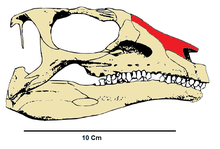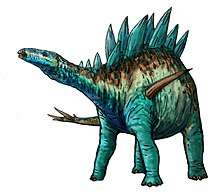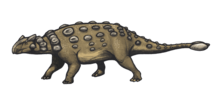Emausaurus
Emausaurus is a genus of thyreophoran or armored dinosaur from the Early Jurassic (Toarcian). Its fossils have been found in Mecklenburg-Vorpommern, northern Germany. Emausaurus is the only known Toarcian thyreorphoran and it is also the only dinosaur from the Ciechocinek Formation with a formal name.[1]
| Emausaurus | |
|---|---|
 | |
| Holotype Skull, red represents unknown material | |
| Scientific classification | |
| Kingdom: | Animalia |
| Phylum: | Chordata |
| Clade: | Dinosauria |
| Order: | †Ornithischia |
| Clade: | †Genasauria |
| Clade: | †Thyreophora |
| Genus: | †Emausaurus Haubold, 1990 |
| Species: | †E. ernsti |
| Binomial name | |
| †Emausaurus ernsti Haubold, 1990 | |
Discovery and naming
The type and only species, Emausaurus ernsti, was named and described by Harmut Haubold in 1990.[2][1] The generic name is composed of an acronym of Ernst Moritz Arndt University of Greifswald and Greek sauros/σαυρος (lizard). The specific name is derived from the name of geologist Werner Ernst, who acquired the fossil, holotype SGWG 85, in the summer of 1963 from foreman Werner Wollin at a loampit near Grimmen, in strata dating from the Toarcian.[1][3][4] It is known by the right side of the skull, the right lower jaw, caudal vertebrae, neural arches, a radius, a metatarsal, a claw, fragments of ribs, scutes and plates, known as EMAU SGWG 85.[1] [5]
Description

Emausaurus was probably a semibipedal to quadrupedal animal, being covered on a armor of osteoderms across the body. Like other thyreorphora, probably was hervivore, concretely a low dwelling one, with a diet more related with ground flora, such as Cycas and Bennnetitales.[1] The body length of the holotype of Emausaurus has been estimated at around 2.5 m, with a weigth of 70-90 Kg.[1] This was based on a juvenile individual though; adult length has been estimated at three to four metres, with a weigth up to 240 Kg.[1] Most of the reconstruction has been based on Scelidosaurus, although it is possible that Emausaurus was a more bipedal animal, as some of the young specimens of Scelidosaurus were thought to be. Adult forms probably where more quadrupedal.[6] Armor includes three conical scutes and one tall, spiny element.[7] David Norman in 2019 examined the morphology of Scelidosaurus, comparing it with Emausaurus. In Emausaurus the maxilla has, overall, a similar morphology to that seen in Scelidosaurus. The disarticulated maxilla of Emausaurus exhibits an anteromedially directed robust process with which it met its counterpart in the midline, creating a wedge-like structure, with no obvious offset between the alveolar margins. In Emausaurus the structure of the frontals is not well preserved. In outline, its proportions resemble those of Scelidosaurus, but the same is true of many Ornithischia. The lacrimal bone of Emausaurus is incomplete, but includes a long, curved jugal process that evidently wrapped itself around the anterior tip of the jugal.[8]
Classification
Cladistic analyses showed that Emausaurus was a basal member of the Thyreophora, more derived than Scutellosaurus, but less than Scelidosaurus.[9] The cladistic status of the specimen is relatively controversial due to its young nature. Clearly it is a member of the Thyreophora, but its position can change by the time, if an adult specimen is found.[10] Emausaurus can be more derived than Scelidosaurus, or even be a sister taxa to Stegosauria.[11]
Paleoenvironment
The holotype of Emausaurus was found on the so-called "Emausaurus type site", from the Ciechocinek Formation dating from the Lower Toarcian (Tenuicostatum).[12] Is is a boundary composed by bituminous shale,[2] that represents an ancient seashore environment, probably lagoonal, and it is contemporaneous of the Posidonia Shale of Southern Germany. Fossil wood has been found on the same location, including driftwood and other related to the Araucariaceae, present in other European environments of Toarcian age.[2] Of the invertebrate fauna insects, bivalves, sea snails and ammonites (Genus Tiltoniceras, Eleganticeras and Lobolytoceras) have been found.[2] The vertebrate fauna is also varied, with fossils of the fish genus Saurorhynchus,[13] and the new genus Grimmenichthys[14] and Grimmenodon.[15] Reptile fossils include Ichthyosauria indet., indeterminate Plesiosauria, rhomaleosaurid plesiosaurs, indeterminate Mesoeucrocodylia (probably Goniopholididae), indeterminate Thalattosuchia[16] and at least two gravisaurian sauropods.[17]
External links
References
- Haubold, H. (1991). Der Greifswalder Dinosaurier ‘‘Emausaurus’’. Fundgrube, 27(2), 51-60.
- Haubold, H. 1990. Ein neuer Dinosaurier (Ornithischia, Thyreophora) aus dem Unteren Jura des nördlichen Mitteleuropa. Revue de Paleobiologie 9(1):149-177. [In German]
- Pereda-Suberbiola, X., Díaz-Martínez, I., Salgado, L., & de Valais, S. (2015). Síntesis del registro fósil de dinosaurios tireóforos en Gondwana. Publicación Electrónica de la Asociación Paleontológica Argentina, 15(1).
- Martill, D. M., Batten, D. J., & Loydell, D. K. (2000). A new specimen of the thyreophoran dinosaur cf. Scelidosaurus with soft tissue preservation. Palaeontology, 43(3), 549-559.
- http://www.paleofile.com/Dinosaurs/Armor/Emausaurus.asp
- Probst, E. (2010). Dinosaurier in Deutschland: von Compsognathus bis zu Stenopelix. GRIN Verlag.
- Norman, D.B.; Witmer, L.M. & Weishampel, D.B. (2004). "Basal Thyreophora". In Weishampel, D.B.; Dodson, P. & Osmólska, H. (eds.). The Dinosauria, 2nd Edition. University of Californian Press. pp. 335–342. ISBN 0-520-24209-2.
- Norman, D. B. (2019). Scelidosaurus harrisonii from the Early Jurassic of Dorset, England: cranial anatomy. Zoological Journal of the Linnean Society. doi:10.1093/zoolinnean/zlz074
- Sereno, P. C. (1997). The origin and evolution of dinosaurs. Annual Review of Earth and Planetary Sciences, 25(1), 435-489.
- Porro, L. B., Witmer, L. M., & Barrett, P. M. (2015). Digital preparation and osteology of the skull of Lesothosaurus diagnosticus (Ornithischia: Dinosauria). PeerJ, 3, e1494.
- Stumpf, S., & Meng, S. (2013). Dinosaurier aus Nordostdeutschland: Verschleppt. Biologie in unserer Zeit, 43(6), 362-368.
- Ernst, W. E. R. N. E. R. (1967). Die Liastongrube Grimmen. Sediment, Makrofauna und Stratigraphie. Ein Überblick. Geologie, 16, 550-569.
- E. E. Maxwell and S. Stumpf. 2017. Revision of Saurorhynchus (Actinopterygii: Saurichthyidae) from the Early Jurassic of England and Germany. European Journal of Taxonomy 321:1-29
- M. Konwert and M. Hörnig. 2018. Grimmenichthys ansorgei, gen. et sp. nov. (Teleostei, 'Pholidophoriformes'), and other 'pholidophoriform' fishes from the early Toarcian of Grimmen (Mecklenburg-Western Pomerania, Germany). Journal of Vertebrate Paleontology 38:e1451871
- S. Stumpf, J. Ansorge, C. Pfaff and J. Kriwet. 2017. Early Jurassic diversification of pycnodontiform fishes (Actinopterygii, Neopterygii) after the end-Triassic extinction event: evidence from a new genus and species, Grimmenodon aureum. Journal of Vertebrate Paleontology 37:e1344679
- Stumpf, S. (2017). A Synoptic Review of the Vertebrate Fauna from the "Green Series" (Toarcian) of Northeastern Germany with Descriptions of New Taxa: A Contribution to the Knowledge of Early Jurassic Vertebrate Palaeobiodiversity Patterns (Doctoral dissertation, Mathematisch-Naturwissenschaftliche Fakultät der Ernst-Moritz-Arndt-Universität Greifswald).
- S. Stumpf, J. Ansorge, and W. Krempien. 2015. Gravisaurian sauropod remains from the marine late Early Jurassic (Lower Toarcian) of North-Eastern Germany.

